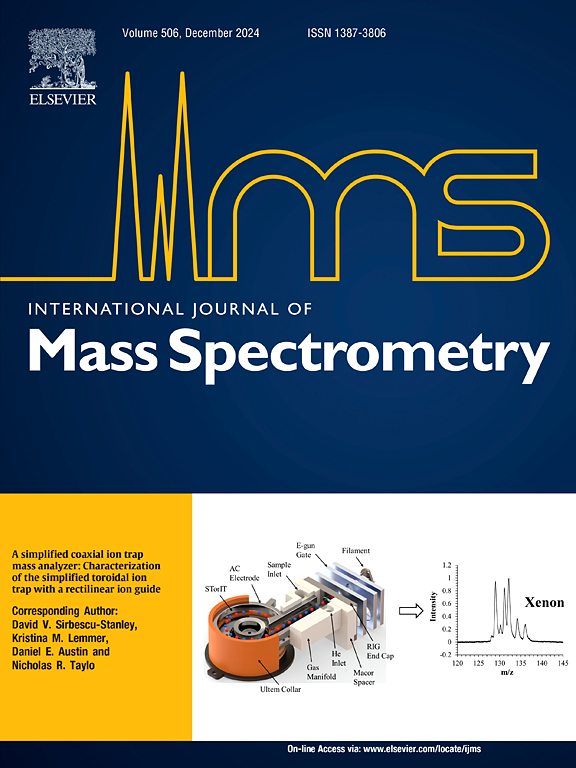碰撞激活的盐化环糊精中潜在开环的环IMS-MS证据
IF 1.7
3区 化学
Q3 PHYSICS, ATOMIC, MOLECULAR & CHEMICAL
引用次数: 0
摘要
目前基于串联质谱的环糊精表征方法依赖于精确的质量和破碎模式。设计正交法是为了提供额外的信息,增加表征的可信度。离子迁移率谱法(IMS)和质谱法(MS)提供两个维度,其中MS根据质量电荷比进行分离,IMS根据大小、形状和电荷进行分离。在此,我们报道了通过环IMS耦合串联质谱揭示的酸化环糊精的新气相行为。在酸化的α-、β-和γ-环糊精分离之前,气相离子活化会产生具有不同迁移率的异构体。在气相迁移分离之后,对活化生成的异构体的碎片化研究表明,与原始的酸化环糊精相比,活化生成的异构体的碎片化程度更大。这些发现表明,酸化环糊精在活化后会发生结构变化,新形成的异构体对观察到的断裂起着重要作用。据我们所知,这是第一次报道在气相中,由酸化环糊精碰撞活化产生的异构体离子的分离。本研究的结果可以用于更好地理解环糊精的断裂,表明断裂发生在初始异构化之后,可能是开环的形式。此外,这些发现可用于开发更具体的环糊精表征方法。本文章由计算机程序翻译,如有差异,请以英文原文为准。

Cyclic IMS-MS evidence for potential ring opening in collisionally activated sodiated cyclodextrins
Current tandem mass spectrometry-based methods for cyclodextrin characterization rely on exact mass and fragmentation patterns. Orthogonal methods are designed to provide additional information, increasing confidence in characterization. Ion mobility spectrometry (IMS) and mass spectrometry (MS) provide two dimensions where MS separates based on mass-to-charge and IMS separates based on size, shape, and charge. Here, we report new gas phase behavior of sodiated cyclodextrins revealed by cyclic IMS coupled to tandem MS. Gas phase ion activation prior to IMS separation on sodiated α-, β-, and γ-cyclodextrins generates isomeric species with different mobilities. Following gas phase mobility separation, fragmentation studies on the activation-generated isomers showed a greater degree of fragmentation than was observed for the original sodiated cyclodextrins. These findings suggest that sodiated cyclodextrins undergo structural changes upon activation, with the newly formed isomers significantly contributing to the observed fragmentation. To our knowledge this is the first report on separation of isomeric ions generated upon collisional activation of sodiated cyclodextrins in the gas phase. The results of this study can be used for better understanding of cyclodextrin fragmentation, suggesting that fragmentation occurs after an initial isomerization, possibly to a ring-opened form. Additionally, these findings can be used to develop more specific methodologies for cyclodextrin characterization.
求助全文
通过发布文献求助,成功后即可免费获取论文全文。
去求助
来源期刊
CiteScore
3.60
自引率
5.60%
发文量
145
审稿时长
71 days
期刊介绍:
The journal invites papers that advance the field of mass spectrometry by exploring fundamental aspects of ion processes using both the experimental and theoretical approaches, developing new instrumentation and experimental strategies for chemical analysis using mass spectrometry, developing new computational strategies for data interpretation and integration, reporting new applications of mass spectrometry and hyphenated techniques in biology, chemistry, geology, and physics.
Papers, in which standard mass spectrometry techniques are used for analysis will not be considered.
IJMS publishes full-length articles, short communications, reviews, and feature articles including young scientist features.

 求助内容:
求助内容: 应助结果提醒方式:
应助结果提醒方式:


